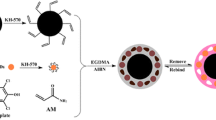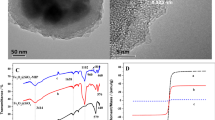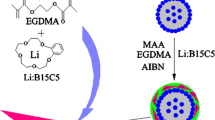Abstract
A magnetic molecularly imprinted composite was prepared by reverse microemulsion using carbon dots (CDs), Fe3O4 as the co-nucleus, and a molecularly imprinted polymer (MIP; with 2,4,6-trinitrophenol as the template) acting as recognition sites. The composite of type CD/Fe3O4@MIPs was characterized by transmission electron microscopy (TEM), energy dispersive spectroscopy (EDS), Fourier transform infrared spectroscopy (FT-IR), zeta potentiometric analysis, X-ray diffraction (XRD) and vibrating sample magnetometry (VSM). The results showed that the composite MIP has a spherical shape with average diameter of 200 nm. They also showed that the composite contains core-shell structures with several Fe3O4 nanoparticles and CDs embedded in each of the microsphere. The composite can extract 2,4,6-trinitrophenol (TNP) and has an imprinting factor of 3.6. It has high selectivity and sensitivity for TNP which acts as a quencher of the fluorescence of the CDs (with excitation/emission maxima at 370/470 nm). The limit of detection of this fluorometric TNP assay is 0.5 nM. The method was successfully applied to the determination of TNP in spiked tap water and river water samples, and recoveries ranged from 89.4% to 108.5% (with an RSD of <6%).

Schematic representation of the magnetic molecularly imprinted composite containing fluorescent carbon dots, Fe3O4 and molecularly imprinted polymer (CD/Fe3O4@MIPs). The CD/Fe3O4@MIPs were applied to the selective and sensitive detection of 2,4,6-trinitrophenol (TNP) by fluorometry.






Similar content being viewed by others
References
Karthik S, Saha B, Ghosh SK, Pradeep Singh ND (2013) Photoresponsive quinoline tethered fluorescent carbon dots for regulated anticancer drug delivery. Chem Commun 49:10471–10473. https://doi.org/10.1039/c3cc46078a
Zhu S, Meng Q, Wang L, Zhang J, Song Y, Jin H, Zhang K, Sun HC, Wang HY, Yang B (2013) Highly photoluminescent carbon dots for multicolor patterning, sensors, and bioimaging. Angew Chem Int Ed 52:3953–3957. https://doi.org/10.1002/anie.201300519
Li W, Zhang HR, Chen S, Liu YL, Zhuang JL, Lei BF (2016) Synthesis of molecularly imprinted carbon dot grafted YVO4:Eu3+ for the ratiometric fluorescent determination of paranitrophenol. Biosens Bioelectron 86:706–713. https://doi.org/10.1016/j.bios.2016.07.034
Li JF, Zhang L, Li PX, Zhang Y, Dong C (2018) One step hydrothermal synthesis of carbon nanodots to realize the fluorescence detection of picric acid in real samples. Sensor Actuat B-Chem 258:580–588. https://doi.org/10.1016/j.snb.2017.11.096
Huang S, Yang EL, Yao JD, Liu Y, Xiao Q (2018) Carbon dots doped with nitrogen and boron as ultrasensitive fluorescent probes for determination of alpha-glucosidase activity and its inhibitors in water samples and living cells. Microchim Acta 185:1–9. https://doi.org/10.1007/S00604-018-2932-1
Li JJ, Jiao YZ, Feng LD, Zhong Y, Zuo GC, Xie AM, Dong W (2017) Highly N,P-doped carbon dots: rational design, photoluminescence and cellular imaging. Microchim Acta 184:2933–2940. https://doi.org/10.1007/s00604-017-2314-0
Ren GJ, Tang MY, Chai F, Wu HB (2018) One-pot synthesis of highly fluorescent carbon dots from spinach and multipurpose applications. Eur J Inorg Chem 2018:153–158. https://doi.org/10.1002/ejic.201701080
Wang DD, Gao D, Xu WJ, Li F, Yin MN, Fu QF, Xia ZN (2018) Magnetic molecularly imprinted polymer for the selective extraction of hesperetin from the dried pericarp of Citrus reticulata Blanco. Talanta 84:307–315. https://doi.org/10.1016/j.talanta.2018.03.010
Yang F, Wang R, Na G, Yan Q, Lin Z, Zhang Z (2018) Preparation and application of a molecularly imprinted monolith for specific recognition of domoic acid. Anal Bioanal Chem 410:1845–1854. https://doi.org/10.1007/s00216-017-0843-3
Chen LX, Xu SF, Li JH (2011) Recent advances in molecular imprinting technology: current status, challenges and highlighted applications. Chem Soc Rev 40:2922–2942. https://doi.org/10.1039/c0cs00084a
Wei X, Yu MM, Li C, Gong XH, Qin F, Wang ZH (2018) Magnetic nanoparticles coated with a molecularly imprinted polymer doped with manganese-doped ZnS quantum dots for the determination of 2,4,6-trichlorophenol. Microchim Acta 185:1–6. https://doi.org/10.1007/S00604-018-2742-5
Liu Y, Hu X, Bai L, Jiang YH, Qiu J, Meng MJ, Liu ZC, Ni L (2018) A molecularly imprinted polymer placed on the surface of graphene oxide and doped with Mn(II)-doped ZnS quantum dots for selective fluorometric determination of acrylamide. Microchim Acta 185:1–8. https://doi.org/10.1007/s00604-017-2543-2
Dai JJ, Dong XQ, de Cortalezzi MF (2017) Molecularly imprinted polymers labeled with amino-functionalized carbon dots for fluorescent determination of 2,4-dinitrotoluene. Microchim Acta 184:1369–1377. https://doi.org/10.1007/s00604-017-2123-5
Liu GL, Chen Z, Jiang XY, Feng DQ, Zhao JY, Fan DH, Wang W (2016) In-situ hydrothermal synthesis of molecularly imprinted polymers coated carbon dots for fluorescent detection of bisphenol a. Sensor Actuat B-Chem 228:302–307. https://doi.org/10.1016/j.snb.2016.01.010
Liang GH, Zhai HY, Huang L, Tan XC, Zhou Q, Yu X, Lin HD (2018) Synthesis of carbon quantum dots-doped dummy molecularly imprinted polymer monolithic column for selective enrichment and analysis of aflatoxin B-1 in peanut. J Pharmaceut Biomed 149:258–264. https://doi.org/10.1016/j.jpba.2017.11.012
Xu XM, Xu GH, Wei FD, Cen Y, Shi ML, Cheng X, Chai YY, Sohail M, Hu Q (2018) Carbon dots coated with molecularly imprinted polymers: a facile bioprobe for fluorescent determination of caffeic acid. J Colloid Interface Sci 529:568–574. https://doi.org/10.1016/j.jcis.2018.06.050
Peng Y, Xie Y, Luo J, Nie L, Chen Y, Chen LN, Du SH, Zhang ZP (2010) Molecularly imprinted polymer layer-coated silica nanoparticles toward dispersive solid-phase extraction of trace sulfonylurea herbicides from soil and crop samples. Anal Chim Acta 674:190–200. https://doi.org/10.1016/j.aca.2010.06.022
Uzuriaga-Sanchez RJ, Khan S, Wong A, Picasso G, Pividori MI, Sotomayor MDT (2016) Magnetically separable polymer (mag-MIP) for selective analysis of biotin in food samples. Food Chem 190:460–467. https://doi.org/10.1016/j.foodchem.2015.05.129
Salinas Y, Martinez-Manez R, Marcos MD, Sancenon F, Costero AM, Parra M, Gil S (2012) Optical chemosensors and reagents to detect explosives. Chem Soc Rev 41:1261–1296. https://doi.org/10.1039/c1cs15173h
Rodgers JD, Bunce NJ (2001) Treatment methods for the remediation of nitroaromatic explosives. Water Res 35:2101–2111. https://doi.org/10.1016/S0043-1354(00)00505-4
Nagarkar SS, Desai AV, Samanta P, Ghosh SK (2015) Aqueous phase selective detection of 2,4,6-trinitrophenol using a fluorescent metal-organic framework with a pendant recognition site. Dalton T 44:15175–15180. https://doi.org/10.1039/c5dt00397k
Ren GJ, Yu LY, Zhu BY, Tang MY, Chai F, Wang CG, Su ZM (2018) Orange emissive carbon dots for colorimetric and fluorescent sensing of 2,4,6-trinitrophenol by fluorescence conversion. RSC Adv 8:16095–16102. https://doi.org/10.1039/c8ra01678j
Nagarkar SS, Joarder B, Chaudhari AK, Mukherjee S, Ghosh SK (2013) Highly selective detection of nitro explosives by a luminescent metal-organic framework. Angew Chem Int Ed 52:2881–2885. https://doi.org/10.1002/anie.201208885
Sukhanov PT, Kushnir AA, Churilina EV, Maslova NV, Shatalov GV (2017) Chromatographic determination of nitrophenols in aqueous media after two-stage preconcentration using an N-vinylpyrrolidone-based polymer. J Anal Chem 72:468–472. https://doi.org/10.1134/S1061934817020137
Barron L, Gilchrist E (2014) Ion chromatography-mass spectrometry: a review of recent technologies and applications in forensic and environmental explosives analysis. Anal Chim Acta 806:27–54. https://doi.org/10.1016/j.aca.2013.10.047
Ho MY, D'Souza N, Migliorato P (2012) Electrochemical aptamer-based sandwich assays for the detection of explosives. Anal Chem 84:4245–4247. https://doi.org/10.1021/ac300606n
Li N, Liu SG, Fan YZ, Ju YJ, Xiao N, Luo HQ, Li NB (2018) Adenosine-derived doped carbon dots: from an insight into effect of N/P co-doping on emission to highly sensitive picric acid sensing. Anal Chim Acta 1013:63–70. https://doi.org/10.1016/j.aca.2018.01.049
Wang YT, Chang XY, Jing N, Zhang Y (2018) Hydrothermal synthesis of carbon quantum dots as fluorescent probes for the sensitive and rapid detection of picric acid. Anal Methods-Uk 10:2775–2784. https://doi.org/10.1039/c8ay00441b
Wu L, Lin ZZ, Zeng J, Zhong HP, Chen XM, Huang ZY (2018) Detection of malachite green in fish based on magnetic fluorescent probe of CdTe QDs/nano-Fe3O4@MIPs. Spectrochim Acta A 196:117–122. https://doi.org/10.1016/j.saa.2018.02.016
Wei X, Meng M, Song Z, Gao L, Li H, Dai J, Zhou ZP, Li CX, Pan JM, Yu P, Yan YS (2014) Synthesis of molecularly imprinted silica nanospheres embedded mercaptosuccinic acid-coated CdTe quantum dots for selective recognition of λ-cyhalothrin. J Lumin 153:326–332. https://doi.org/10.1016/j.jlumin.2014.03.055
Wang CL, Hu XL, Guan P, Wu DF, Qian LW, Li J, Song RY (2015) Separation and purification of thymopentin with molecular imprinting membrane by solid phase extraction disks. J Pharmaceut Biomed 102:137–143. https://doi.org/10.1016/j.jpba.2014.07.016
Zhou C, Wu H, Wang M, Huang C, Yang D, Jia N (2017) Functionalized graphene oxide/Fe3O4 hybrids for cellular magnetic resonance imaging and fluorescence labeling. Mat Sci Eng C-Mater 78:817–825. https://doi.org/10.1016/j.msec.2017.04.139
Hao T, Wei X, Nie Y, Xu Y, Yan Y, Zhou Z (2016) An eco-friendly molecularly imprinted fluorescence composite material based on carbon dots for fluorescent detection of 4-nitrophenol. Microchim Acta 183:2197–2203. https://doi.org/10.1007/s00604-016-1851-2
Li X, Wang W, Li Q, Lin H, Xu Y, Zhuang L (2018) Design of Fe3O4@SiO2@mSiO2 -organosilane carbon dots nanoparticles: synthesis and fluorescence red-shift properties with concentration dependence. Mater Design 151:89–101. https://doi.org/10.1016/j.matdes.2018.04.051
Han S, Li X, Wang Y, Su C (2014) A core-shell Fe3O4 nanoparticle-CdTe quantum dot-molecularly imprinted polymer composite for recognition and separation of 4-nonylphenol. Anal Methods-Uk 6:2855. https://doi.org/10.1039/c3ay41924j
Gan XJ, Liu SP, Liu ZF, Hu XL (2012) Determination of Tetracaine hydrochloride by fluorescence quenching method with some aromatic amino acids as probes. J Fluoresc 22:129–135. https://doi.org/10.1007/s10895-011-0938-8
Gan XJ, Liu SP, Liu ZF, Hu XL, Tian J, Xue JX (2013) Fluorescence quenching method for the determination of carbazochrome sodium sulfonate with aromatic amino acids. Luminescence 28:265–269. https://doi.org/10.1002/bio.2375
Xie ZC, Sun XF, Jiao JM, Xin X (2017) Ionic liquid-functionalized carbon quantum dots as fluorescent probes for sensitive and selective detection of iron ion and ascorbic acid. Colloid Surface A 529:38–44. https://doi.org/10.1016/j.colsurfa.2017.05.069
Sinduja B, John SA (2018) Sensitive determination of rutin by spectrofluorimetry using carbon dots synthesized from a non-essential amino acid. Spectrochim Acta A 193:486–491. https://doi.org/10.1016/j.saa.2017.12.067
Acknowledgments
This work was supported by the talent introduction program of Southwest medical university (NO. 090300040004), the university level fund of Southwest medical university (NO. 2017-ZRQN-032) and the joint program of Luzhou government-Southwest Medical University (NO. 2015LZCYD-S07(2/5)).
Author information
Authors and Affiliations
Corresponding author
Ethics declarations
The author(s) declare that they have no competing interests.
Additional information
Publisher’s Note
Springer Nature remains neutral with regard to jurisdictional claims in published maps and institutional affiliations.
Electronic supplementary material
ESM 1
(DOCX 2.03 kb)
Rights and permissions
About this article
Cite this article
Wang, M., Fu, Q., Zhang, K. et al. A magnetic and carbon dot based molecularly imprinted composite for fluorometric detection of 2,4,6-trinitrophenol. Microchim Acta 186, 86 (2019). https://doi.org/10.1007/s00604-018-3200-0
Received:
Accepted:
Published:
DOI: https://doi.org/10.1007/s00604-018-3200-0




